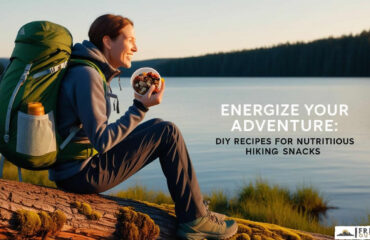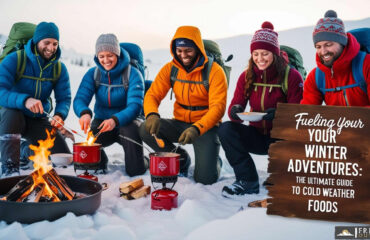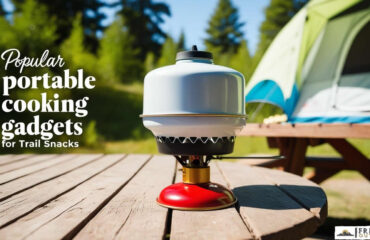Essential Nutrient-Dense Snacks to Fuel Your Cold Weather Hiking Adventures

The Importance of Nutrient-Dense Snacks for Cold Weather Hiking
When embarking on a cold weather hike, the right snacks can play a vital role in maintaining your energy levels and keeping you warm. Cold temperatures can increase your calorie burn significantly, with estimates suggesting that you may need up to 100 extra calories every 15 minutes when shivering. This means that having nutrient-dense snacks is essential to prevent fatigue, enhance mental clarity, and ensure you can enjoy your hiking experience without feeling drained.
Moreover, consuming nutrient-rich snacks regularly can help sustain your energy levels throughout the hike. For example, having a small handful of trail mix every hour can keep your body fueled and your spirits high. Hiking snacks should not only be packed with the right nutrients but also be easily accessible, allowing for quick refueling stops that minimize downtime on the trail.
Recommended Nutrient-Dense Snacks
High-Energy Options
During winter hikes, it’s essential to opt for snacks that provide a good mix of carbohydrates, proteins, and fats. Nuts and seeds are excellent choices, rich in healthy fats and proteins that offer sustained energy. For a quick energy boost, dried fruits like apricots or raisins are fantastic due to their high sugar content. Energy bars can also be beneficial, but it’s crucial to choose those that include a balanced mix of macronutrients. Dark chocolate can be a delightful addition, providing both an energy lift and antioxidants. A homemade trail mix that combines nuts, seeds, and dried fruits can be a convenient and nutrient-rich option that’s easy to carry.
Portable and Lightweight Snacks
When hiking in cold weather, it’s crucial to pack snacks that are portable and lightweight, and won’t freeze solid. Granola bars (especially the non-gooey types) are ideal as they maintain their form in colder temperatures and provide a quick energy source. Cheese sticks and pepperoni sticks are also great for their high protein and fat content, and they don’t freeze easily. Nut butter stuffed dates are another excellent option, offering convenience and energy without being messy. For quick snacking, consider packing pop tarts or chips, which are tasty and easy to eat on the go, avoiding the risk of freezing.
Hydration Tips for Cold Weather Hiking
Staying hydrated during winter hikes is just as crucial as consuming the right snacks, and it requires deliberate effort given the unique challenges posed by cold weather. Cold temperatures can significantly suppress your thirst, making it easy to overlook your hydration needs. This can lead to dehydration, which may impair your performance and increase the risk of hypothermia. To combat this, aim to consume approximately 250 ml of water every 15-30 minutes, ensuring that you’re regularly replenishing your fluids and maintaining hydration levels. It’s also beneficial to monitor your urine color, as pale yellow generally indicates proper hydration, while darker colors may suggest a need for more fluids.
Incorporating hot fluids into your hydration strategy is another effective way to stay warm and motivated to drink more. Carrying tea, coffee, or even hot chocolate in a thermos can not only encourage regular intake but also provide a comforting warmth that enhances your hiking experience. Insulated water bottles are a smart choice for cold weather, as they help prevent your water from freezing, and storing them upside down can further reduce the risk of ice formation. To enhance hydration, consider adding electrolyte tablets to your drinks. These can help replace lost minerals and maintain a proper balance in your body, particularly after strenuous activities. Remember, staying hydrated is a vital part of enjoying your winter hiking adventures, so make it a priority!
Packing and Storing Snacks
Properly packing and storing your snacks is essential to keep them from freezing during your cold weather hike. One effective strategy is to keep snacks close to your body, where they can stay thawed from your warmth. For example, storing energy bars or trail mix in an inner pocket of your coat or in a thermal pouch can help maintain their desired texture and flavor. Wide-mouth containers can make it easier to access snacks without risking freezing, and insulated options are even better for maintaining temperature. This is particularly helpful for items like cheese sticks or nut butter packets, which can be difficult to handle if they have frozen.
When selecting snacks to bring along, it’s important to avoid those that are prone to freezing, such as gummy candies or gooey bars. Instead, consider options like chips, cookies, or even hard candies that can withstand the cold without losing their form. Vacuum-sealed bags can also help keep snacks fresh and prevent moisture buildup, which is crucial in cold weather where condensation can lead to sogginess. Additionally, labeling bags with contents and energy information can make it easier to grab what you need while on the trail, ensuring you maintain energy levels throughout your hike. This thoughtful approach to packing will not only keep your snacks in good condition but also enhance your overall hiking experience.
Balancing Nutrients in Hiking Snacks
To fuel your body effectively during cold weather hikes, it’s essential to maintain a balanced mix of carbohydrates, proteins, and fats in your snacks. This balance not only ensures sustained energy but also helps your body cope with the increased calorie needs that arise in colder conditions, where you may burn significantly more calories to maintain warmth. For instance, snacks like almonds provide healthy fats and protein, while cheese delivers both protein and calcium, making them excellent choices. Moreover, dark chocolate offers a quick energy boost along with antioxidants, which can be particularly refreshing during a long trek. Including these nutrient-dense options can help you stay energized and focused on the trail.
Eating generates heat, a process known as thermogenesis, which is particularly beneficial for maintaining your warmth in chilly temperatures. By pairing your snacks with warm drinks, such as soup, hot chocolate, or even herbal teas, you can enhance energy absorption while also keeping your core temperature up. For example, sipping on a thermos of hot soup during a break not only satisfies hunger but also provides a comforting warmth that can be essential in cold conditions. Additionally, it’s important to regularly monitor your body’s response to different snacks and adjust your intake based on how you feel during your hike. This approach helps to ensure that you have the right fuel to keep your energy levels steady, allowing you to enjoy your adventure without the fatigue or discomfort that can arise from poor nutrition choices.
Tips for Enjoyable Cold Weather Hiking
To make your cold weather hiking experience more enjoyable, it’s essential to consume snacks regularly, ideally every hour. This practice can help stave off both hunger and fatigue, ensuring that you maintain your energy levels throughout the hike. For instance, consider packing a variety of snacks, from trail mix to energy bars, allowing you to switch things up and keep your palate engaged. Not only does this prevent monotony, but it also ensures that your body receives the diverse nutrients it needs to perform well in cold conditions.
Experimenting with different snack types can help you identify the right balance that meets your energy requirements and personal taste preferences. You might find that you crave something sweet after a steep ascent, making dark chocolate or dried fruits a perfect choice for a quick energy boost. Incorporating fun and creative snack options, such as colorful fruit leather or homemade nut butter stuffed dates, can also enhance your motivation while traversing the trails. Moreover, planning your snack breaks in sheltered areas, such as behind a large rock or in a grove of trees, can significantly minimize heat loss while you eat, making the experience more comfortable and enjoyable.
Engaging in social snacking by sharing treats with fellow hikers can foster camaraderie and enhance the overall hiking adventure. Imagine enjoying a warm cup of hot cocoa or sharing your favorite energy bars with friends, creating a sense of community and building lasting memories in the great outdoors. These moments not only boost morale but also provide a great opportunity to recharge and reflect on the day’s journey together. So, pack those snacks thoughtfully, and prepare for an invigorating hiking experience that nourishes both body and spirit!




